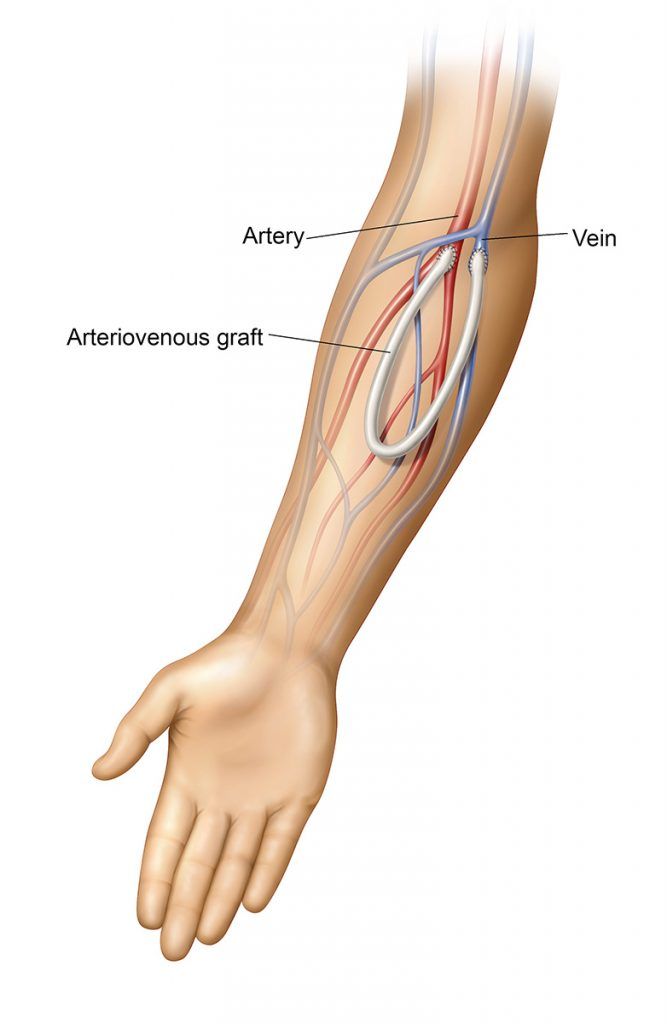
If your doctor has recently told you that you need dialysis access, you’re probably looking for as much information as possible about the types of access available. Understanding the different types of dialysis access will help make you more comfortable with what your doctor suggests. An arteriovenous graft, also referred to as an AV graft, is often a good option for patients with veins that would not allow for the creation of an arteriovenous fistula (AV fistula).
What is an AV Graft?
 An AV fistula is usually the preferred option, if you’re a good candidate.
An AV fistula is usually the preferred option, if you’re a good candidate.
Veins that are too small or too weak to support an AV fistula might mean an arteriovenous graft is the next best option. Just like with an AV fistula, an AV graft is created surgically. But instead of connecting an artery directly to a vein, like with an AV fistula, for an AV graft, a vascular specialist will connect one end of a small synthetic tube, the actual graft, to one of your veins, and the other end to one of your arteries.
In 2013, 15% of people receiving hemodialysis at the end of their first year of dialysis had an AV graft.
If you and your doctor decide an arteriovenous graft is your best option, you will undergo a procedure called vessel mapping, which can be performed on an outpatient basis. You’ll be given local anesthetic, and a sedative before a vascular specialist makes two small incisions at the selected site for AV graft placement, usually in your non-dominant arm. The vascular specialist will then access the artery and vein and connect them by sewing one end of the graft (or synthetic tube) to your vein and the other end to your artery. AV grafts are ready to use in a much shorter time than an AV fistula, which may be a consideration in selecting the best type of access for you.
Who Can Get an Arteriovenous Graft?
The AV fistula is considered the “gold standard”, but it is not the best choice of access for everyone. However, if you have damaged or occluded veins and arteries, this type of access may not be a good option either.ii
Caring for Your Arteriovenous Graft
After dialysis access surgery, you may experience some pain and swelling near the access site. This is normal and should improve within a few days. But before your AV graft can be used, it needs to heal.
An AV graft will usually heal and be ready for use within 3 to 4 weeks from the time it was placed. In selected cases an “early stick graft” may be used, which will reduce the time needed between placement and first use to a few days.iii On average an AV fistula takes 4 months before it is ready for use.i
Once your graft has been placed, you’ll be able to feel it beneath your skin. You will feel a vibration, or thrill if you place your fingers over the graft. This vibration is an indication of the blood flowing through your graft. This vibration, or thrill, is an important indicator of how well your graft is working. If you place your ear over the graft, you’ll be able to hear the blood moving through it. This sound is called a bruit.
Caring for your AV graft is very important. Besides washing your access site every day, you’ll need to check to see that the graft is still working properly. An easy trick is to remember the words look, listen and feel. Let’s take a look at how these words can help you remember how to check your AV graft on a daily basis.
Look – Watch for signs of infection (redness, swelling or discharge) and changes in the appearance of the skin over and near the graft.

Listen – Check for the sound of blood moving through your graft by putting your ear, or a stethoscope if you have one, over your AV graft.

Feel – Ensure blood is flowing through the graft by feeling for the vibration or thrill.

You should not strain the arm where your graft is located by picking up heavy objects, sleeping on it or putting undue pressure on it by wearing a watch or carrying a handbag over the graft location.iv If during the healing process you notice any signs of infection, or your hand changes color or temperature, contact your doctor right away.
Related: What to Do If Your Dialysis Access Is Not Working Properly
Advantages of an Arteriovenous Graft
While an arteriovenous graft is not considered the “gold standard” dialysis access, it’s often considered the next best thing. There are some advantages compared to the other types of hemodialysis vascular access. These advantages of an AV graft include:
- An AV graft is usually ready for use within anywhere from a matter of days (for the “early use” grafts) to 3 – 4 weeks of being placed.
- An AV graft is easy to implant.
- An AV graft has a lower chance of infection than a catheter does.
- Once it heals, you can shower.
Disadvantages of an Arteriovenous Graft
Despite the advantages to this type of dialysis access, there are disadvantages as well, which is why it’s not considered the best choice for everyone.
- An AV graft doesn’t last as long as an AV fistula does.
- Unlike with a catheter, needles are still required to access the AV graft.
- AV grafts are more prone to clotting than AV fistulas are.v
For some people, AV grafts are the best option for dialysis access. And if you’re one of these people, remember that taking care of your access will help your access take care of you.
Sources:
i United States Renal Data System. Accessed from: https://www.usrds.org/2015/view/v2_04.aspx?zoom_highlight=fistula%20at%20initiation
ii http://www.infodialysisaccess.com/arteriovenous-av-graft/
iii Al Shakarchi J, Houston G, Inston N. Early cannulation grafts for haemodialysis: A systematic review. J Vasc Access. 2015;16(6):493-497. doi:10.5301/jva.5000412.
iv National Institutes of Health. Accessed from: https://www.niddk.nih.gov/health-information/kidney-disease/kidney-failure/hemodialysis/vascular-access
v University of Southern California, Keck School of Medicine. Accessed from: http://www.surgery.usc.edu/vascular/vascularaccess.html


